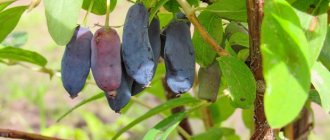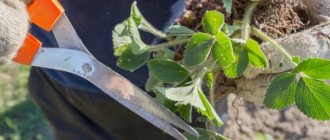Category: For flowers and indoor plants Reading time: 8 min · Views: 5,730
Ficus is a tropical plant that was loved by Russian gardeners a hundred years ago. This beautiful ornamental bush needs warmth, moisture and special fertilizers. What should the ficus be fed so that it does not turn yellow and drop its leaves? It turns out that the secret lies in the correct proportion of minerals and vitamins. In this article we will consider the technology of growing ficus in an apartment.
Conditions for proper development
Ficus benjamina feels good in a spacious pot. This does not mean that you need to immediately plant it in a flowerpot, you just need a pot where the plant will freely take root. At the same time, the ficus does not like frequent transplants and changes of place of residence; for this it needs constancy. He reacts to all changes with protest - he sheds his leaves.
The plant needs moderate watering, always with warm, settled water. Excess moisture and low temperatures lead to rotting of the roots. Therefore, excess water that has flowed into the pan must be drained immediately.
The shower for Ficus Benjamin should also be warm, and after that the leaves should be wiped with a damp cloth. Otherwise, dusty stains will remain on the leaves, and the plant does not like this.
Pot size and soil composition
The choice of flowerpot for ficus depends on its size and type. For example, ceramics or plastic work well for small bushes. For large specimens, purchase wooden containers or a capacious plastic flowerpot. The main thing is that the roots are not crowded. If you do not want to grow a large bush, do not transplant it into a large flowerpot - leave it as is. The roots will not have enough space, and they will not grow in length and branch.
In what soil do ficus grow best? You can purchase a special mixture for them at flower shops, or you can prepare it yourself. The soil mixture consists of the following ingredients:
- peat;
- humus;
- sand.
All parts are taken in equal measure and mixed well. To fill a large pot, you can add turf soil. A layer of charcoal or expanded clay is poured onto the bottom of the flowerpot for the drainage system. The soil is pre-treated with an antiseptic mixture to destroy harmful microorganisms and fungal spores. If you take ordinary soil from the garden, it must first be enriched with mineral fertilizers and nutrients.
Nutrition needed by ficus and signs of its deficiency
To know exactly what fertilizers are needed for Ficus Benjamin, you need to understand what the ficus eats.
For the proper development of a plant, it needs various macro- and microelements. There are 13 of them in total, nitrogen is considered the main one. It is nitrogen that forms the green mass and is responsible for the rich color of the leaves. Thanks to it, photosynthetic processes proceed normally.
Ficus also needs:
- In phosphorus, thanks to which the root system of the plant grows and develops and resistance to diseases increases.
- Potassium, thanks to which the plant tolerates short-term droughts well.
- Calcium, which improves the metabolic processes of the flower.
These are the main elements; additional elements include magnesium, manganese, sulfur, iron, zinc, copper, molybdenum, cobalt, and boron.
When the soil begins to lack certain nutrients, the flower starves. This can be seen by the following signs:
- Growth slows down and then stops completely.
- The stems stretch and become thin.
- The leaves become pale and yellow spots appear.
- The elasticity of the leaves is lost, they can dry out and die.
- The plant's immune system begins to work poorly, so susceptibility to disease increases.
- Low resistance to pests.
Feeding Ficus Benjamin should be done regularly until the above signs begin to appear.
The ficus will also react to excessive fertilization: it will shed its leaves and the soil will become covered with a white coating.
How to feed ficus at home
The plant needs adequate nutrition. These flowers are not often replanted, so the content of nutrients in the soil is depleted. Quickly using up the reserves available in the soil, the tree begins to experience a lack of minerals and trace elements.
Which component is missing for full development can be determined by the appearance of the flower:
- stopping growth indicates a lack of nitrogen in the soil;
- deformation and excessive stretching of branches is a sign of phosphorus deficiency;
- iron deficiency contributes to the appearance of pigmentation on leaves;
- faded leaf color - lack of potassium and calcium.
Important! Adding fertilizers to the soil will help restore the appearance and prevent the death of the flower.
How to properly feed ficus benjamina
Fertilizers are needed for the active growth and development of the plant. This is especially important during the growing season.
In summer, the flower needs to be fed with nitrogen-containing fertilizer. After this, the growth of deciduous mass will begin. This feeding is also suitable for rehabilitating a damaged plant.
Since this flower is quite tall (at home it grows up to 3 meters), fertilizers for Ficus Benjamin should be varied. You can purchase ready-made fertilizers in specialized stores or prepare them yourself at home.
Before feeding, you need to make sure that the ficus does not become crowded in the pot. As usual, it is replanted once every 4 years, when the roots completely entangle the soil in the pot. It is best to replant ficus in spring or autumn when it is warm.
It is not necessary to prepare the soil for replanting yourself; it is easier to purchase a special soil mixture for ficuses in the store. In special soil the plant will take root faster.
Fertilizers for Ficus Benjamin will depend on several factors: soil, age of the plant, season. For example, if the substrate does not contain soil, it means that it contains absolutely no nutrients, and in this case, fertilizing is carried out all year round. Conventional soil mixtures are periodically fed with organic or mineral fertilizers. As a rule, fertilizing is carried out in the summer, every two weeks.
Nettle infusion
Another fertilizer for ficus is plant humus and herbal infusion. If there is no animal humus, then leaf or compost will do. This is also an effective food for ficus. Plant humus is rich in nitrogen compounds and other elements. It is enough to dilute 100 g of such humus in 1 liter of water.
In the summer, flower growers prepare infusions of weeds for feeding. Nettle infusion works best for ficus plants. This fiery green contains nitrogen and carbon. It is best to collect nettles in early summer, before the seeds are ripe. It is enough to chop the young stems and leaves, place them in a plastic bottle or bucket, and then fill them with water 1:1. The product is infused for two weeks. When the infusion ferments, it will darken. Nettle infusion is applied to the root zone, first diluted with water 1:10.
In dry summers, nettle infusion will also help fight pests. Ficus leaves are simply sprayed with nettle water infused for 24 hours.
How often to feed ficus
Fertilizing ficus benjamina at home is not done as often as other house flowers. But at the same time, the amount of nutrients should be sufficient for proper nutrition.
The larger the plant's canopy, the more nutrients it will need. In about two months, the ficus completely depletes the soil.
Intensive feeding will be required during the active growth of the plant - in the spring and summer.
The last time fertilizing ficus at home is carried out at the end of September. When cold weather sets in, the ficus goes into a dormant state and all processes slow down. The need for nutrition is reduced; there is no need to fertilize it during this period.
If the room where the ficus is grown is warm and light enough, fertilizing can be continued, but the rate and frequency must be reduced.
Organic fertilizers for Benjamin and other varieties
For successful maintenance of ficus, organic fertilizers are no less important. They improve the structure of the soil and enrich it with useful elements. Thanks to such additives, the air permeability of the soil increases, which has a positive effect on flower growth.
The category of organic fertilizers includes:
- peat;
- compost;
- humus;
- bird droppings.
Important! Some organic fertilizers have a specific unpleasant odor.
When applying a solution of high concentration, they can destroy the flower. Organic mixtures from specialty stores can be a worthy alternative.
Nettle infusion
The folk remedy allows you to saturate the soil with nitrogen, iron and carbon. This is one of the best ways to feed indoor flowers. It is often also used to mulch the soil.
To prepare the solution, you need to do the following:
- Collect nettle shoots that have not yet formed seeds.
- Grind, pour into a container (the shoots should fill it halfway).
- Cover with a lid and place in a dark place.
- Leave for 2-3 weeks.
- Dilute the resulting composition with water 1 to 10 and water the flower.
- A solution with a concentration of 1 to 20 can be used for spraying.
Reference! The readiness of the infusion is indicated by the dark green color and the presence of bubbles on the surface.
Vegetable humus
This type of fertilizer is easy to make yourself. To do this you will need a variety of plants and foliage. Rotten plants are a supplier of nitrogen and many other microelements that are useful for indoor flowers. The resulting humus is diluted in water in a ratio of 1:10 and watered over the tree.
Humus (chicken droppings and mullein)
The classic version of organics is chicken manure or koryak. These are sources of nitrogen, which is needed for leaf growth.
Chicken manure is concentrated organic matter. It is not used in its pure form.
This product is applied in the spring and summer when active growth is observed. It is recommended to take 5 g of rotted droppings per 1 liter of water. The result is a cloudy liquid with a pale green hue. It should be applied only after abundant watering.
Cattle manure is composted before use. Fresh fertilizer can burn the root system. For 1 g of organic matter, take 1 liter of water.
Wood ash
The ash can be used as a dry fertilizer, sprinkled under the roots of the ficus, or prepared as a liquid solution. To do this, pour 1 tablespoon of wood ash with a liter of boiling water. The slurry is infused for seven days. Water the plant with the resulting mixture and spray the foliage.
Important! While the solution is infused, it must be shaken daily.
With the help of ash, the plant receives several useful substances at once:
- nitrogen;
- phosphorus;
- potassium.
succinic acid
Succinic acid can be purchased at a pharmacy. One tablet is diluted in 1 tbsp. l. water. Such a remedy:
- activates the growth process;
- increases the turnover of the immune system and resistance to diseases.
For preventive purposes, a solution of succinic acid is used to spray ficus.
Spilled tea and coffee
The grounds remaining after drinking black tea or coffee will serve as an excellent fertilizer for ficus, enriching the soil with oxygen. The remains of coffee or tea leaves are poured into the pot and lightly covered with earth. It is impossible to leave fertilizer on the surface, as it contributes to the appearance of midges and mold.
Important! It is unacceptable to use fresh coffee or tea as fertilizer. A high concentration of nitrogen will destroy the roots and cause the death of the plant.
Fruits and sugar
Sugar will give the plant a boost of energy. It can be used by adding it to the soil, or as a liquid solution. For this, 1 tbsp. A spoonful of sugar is diluted in a liter of water and watered over the ficus.
Fruits provide the soil with many beneficial substances that have a beneficial effect on plant nutrition. The following is used as fertilizing:
- citrus peels;
- banana peel;
- a decoction in which fruits were boiled.
The most effective and popular is an infusion made from banana peels. To prepare it you need:
- Grind the peel.
- Pour boiling water over it.
- Leave for 24 hours.
- Strain.
The infusion is used to water the plant no more than once every 2 months.
Reference! It is permissible to bury fresh banana peelings in the pot.
Yeast
The product is used to feed the flower during the period of active growth. 1 tablespoon of dry yeast is dissolved in 10 liters of warm water and used for watering. Yeast activates the activity of microorganisms contained in the soil.
Not all fertilizers are suitable for ficus. Some will not only be ineffective, but also unsafe. These include: Potassium permanganate . This product can burn the plant. Sweet water . Sugar diluted in water will cause midges to appear.
What kind of fertilizers are there for ficus benjamina?
Based on their origin, fertilizers are divided into two main types: mineral and organic.
Mineral fertilizers are inorganic compounds that are produced industrially. They contain a very high concentration of useful substances, which means they will give a positive effect faster.
Organic fertilizers are the decomposing remains of plant and animal organisms. They nourish plants well, improve soil, and improve the functioning of beneficial microorganisms, but their action is slower.
The best fertilizer for Ficus Benjamin is alternating mineral and organic fertilizers. This approach will provide the flower with the necessary nutrition for full development.
Growing ficus and caring for the plant
For ficuses, not only feeding is important, but also proper care. The tree loves well-lit places. For ficus plants to thrive, provide them with plenty of light. Dark green ficuses also tolerate shade well. But variegated plants want direct sunlight. In winter, you can provide them with additional lighting, otherwise they may shed their leaves. Buy a special lamp and try to keep the plant exposed to light for at least 12 hours a day. To ensure that the ficus crown forms beautifully, turn the flower from different sides to the light source from time to time.
Ficus plants like moist air. Spray the plant regularly and give it a shower. Ficus trees with large leaves collect a lot of dust, so wipe them with a damp cloth or sponge.
Ficus trees also love warmth. They feel most comfortable at temperatures of +25-30 °C in summer and +18-20 °C in winter. Green-leaved species are more tolerant of low temperatures than variegated ones. Ficus does not like drafts and overcooling of the soil, so do not place it on the floor or a cold windowsill.
Another important condition for maintaining ficus is proper watering. Do you know how many times to water your ficus in the summer? Two generous waterings per week are sufficient. But in winter - once moderately. Wait between waterings until the soil is dry but not dry. Ampelous ficuses love more water than ordinary ones.
Your favorite type of ficus can be easily propagated by cuttings. It is enough to cut one branch with a leaf and root it. You can use special products to stimulate root growth. Most often, cuttings take root easily and quickly. During the growth process, try to form a beautiful crown for the ficus. To do this, use trimming and pinching. There is no need to replant trees often; it is enough to do this once every two to three years.
Mineral fertilizers
Today there are quite a few different fertilizers specifically for Ficus Benjamin. They contain minerals in the right ratio.
All drugs differ in the form of release:
- Dry - in powder, tablets, granules. Solutions are prepared from them or placed in the soil. In the latter case, they gradually dissolve when watered.
- Liquid - they are used to carry out root and foliar treatment of plants. They are distinguished by their fast action.
- Sticks - they are loved for their prolonged action (up to several months). Place next to a flower in a pot. Allows you to save time on caring for the plant.
Homemade household fertilizers
There is always household waste in the kitchen, which experienced housewives have learned to use as fertilizer, including ficus plants. What can be added to the soil as fertilizer?
Try this:
- Sugar water. It contains glucose, which gives energy to ficus plants and nourishes them. It is enough to dilute two tablespoons of sugar per liter of water and water once a month.
- Coffee grounds. It promotes loosening of the soil and its air permeability. After it, the roots are better fed with oxygen. First, dry the grounds and then mix them with the soil in the pot. Do not leave coffee on top, otherwise midges will appear.
- Tea leaves. Ficus plants love regular black tea. Herbal and green can only serve as a leavening agent. Do not add too much tea leaves to the pot, otherwise mold and midges will appear.
- Peels of vegetables and fruits. You don’t have to throw away the skins of bananas, oranges, and potatoes - use them as top dressing. First, grind them, boil them, and leave them in this water for about three days. Then pour the infusion over the ficus.
The most popular fertilizers for ficus that are easy to use at home
- Humus of animal origin is a natural source of nitrogen. It is this fertilizer that is used for ficus benjamina to thicken the leaves. The most beneficial substances are found in bird droppings. Bird droppings products are even superior to manure. They act very quickly, almost like mineral fertilizers. It must be remembered that bird droppings are used only in the form of a solution. Ficus Benjamin can be fed with humus from the manure of cattle, horses, pigs, etc. It is also used in the form of a solution.
- Plant humus - in this case, plant debris decomposes. This fertilizer has many essential microelements, and a solution is also made from it.
- Nettle. Nettle fertilizer contains elements such as nitrogen, potassium and magnesium. It is used to strengthen the root system, accelerate plant development, and improve soil condition. Leaves and stems must be prepared in advance, before the seeds appear on the nettles. Fill half a plastic bottle with nettles, add water and leave to ferment for 2 weeks. The result is a dark green liquid, which is diluted with water for use. Ficus should be watered with a solution in a ratio of 1:10, and sprayed with a solution of 1:20. The proportions should not be violated, as you can burn the leaves and roots.
- Wood ash. It contains quite a lot of different elements, including potassium and phosphorus. An infusion is made from ficus ash: 1 tsp. ash is poured into 1 liter of boiling water and left for 7 days. This infusion is used to water the flower. Also, to protect the plant from pests, you can dust the leaves with ash.
- Succinic acid. If Benjamin's ficus sheds its leaves, fertilizer is usually not required for it; this is a reaction of the flower to external stimuli, such as frequent replanting, change of residence or improper care. If there have been no changes in the life of the flower, you can feed it with a crystalline colorless substance - succinic acid. It promotes flower growth, increases its vitality, and improves soil microflora. To fertilize, you first need to prepare a concentrate: dissolve 1 g of succinic acid in 1 liter of water. For spraying leaves, this concentrate is diluted with water in a ratio of 1:1, for root watering - in a ratio of 1:4. It is recommended to feed ficus with succinic acid once a year; the finished concentrated liquid is stored for no more than 3 days.
Thus, fertilizers for Ficus Benjamin at home can be completely different, the main thing is to accurately observe the proportions when using them.
Fertilizer for density
To increase the density of the crown, it is recommended to use succinic acid. These are colorless crystals that dissolve in water. The ficus is watered with a liquid mixture or the crown is sprayed.
Succinic acid prevents the shedding of leaves and their withering, strengthens the roots of the plant, and stimulates the development of the crown. To prepare the solution, mix 1 g of acid and 1 liter of water. Add to the root for three days. The procedure is carried out once a year.
Root feeding
Root feeding is watering the plant with nutrient solutions and is the most common method. But in order not to harm the plant, this procedure must be carried out wisely. It will benefit the flower if you adhere to the following rules:
- Read the manufacturer's instructions and follow them exactly. The dosage can be adjusted according to the appearance of the ficus.
- Sick plants do not need to be fed - in this state they do not absorb nutrients. The flower must first be treated with fungicides and wait until it has fully recovered.
- It is not recommended to feed the ficus immediately after transplantation; you need to wait 20-30 days for the plant to adapt and restore damaged roots.
- To prevent burns to the ficus root system, all fertilizing is applied only to moist soil.
Fertilizers for root feeding can be different: both dry and liquid. It is important that the composition is evenly distributed throughout the pot so that all roots receive nutrition.
When to use fertilizer
It is not advisable to fertilize ficus immediately after transplantation. The first feeding can be done after 1-1.5 months, when the flower has fully adapted.
The need for feeding may be indicated by a change in the appearance of the plant, shedding of leaves and slowing growth. It is best to fertilize the ficus regularly, avoiding the appearance of external signs of soil depletion. The optimal frequency of applying complex fertilizers is every 10-14 days.
Foliar feeding
Ficus plants also love foliar feeding. Through the leaves, nutrients are absorbed faster by plants. Often, foliar treatment is used in emergency cases when the roots cannot take nutrition from the soil. This procedure works very quickly, and the result is visible immediately. But solutions for spraying leaves are very weak, so they cannot completely replace the main feeding.
To maximize the effect of the treatment, it is important to carry it out correctly. The leaves need to be sprayed with a spray bottle, always on both sides. At the bottom of the leaf there are more stomata, through which the fertilizer will be absorbed.
It is very important to prepare the solution for treatment correctly, that is, not to exceed the recommended dosage. Fertilizer can burn the leaves, then the ficus will get sick and die.
Fertilizing with wood ash
Gardeners and flower growers call wood ash a source of magnesium, potassium, and calcium. Ficus can be fertilized with tincture from it. Ash is often added to the soil mixture when replanting a plant. Prepare the tincture at the rate of 1 tablespoon of ash per 1 liter of boiling water. Leave to infuse for a week. Stir the solution daily. Water the ficus with the finished tincture. You can also use ash to dust the plant to prevent fleas and slugs.
Signs of improper fertilization
The procedure must be carried out in compliance with proportions, since both a shortage and an excess of useful components can negatively affect the condition of the ficus and even lead to the death of the flower.
- Signs of improper feeding are:
- the formation of a white coating on the soil surface;
- yellowing of leaves;
- partial or complete loss of foliage;
- the appearance of brown spots on the leaf blades;
- stem stretching;
- blackening of leaves;
- curling of leaves.
If at least one of the listed symptoms is present, the portions of fertilizers should be adjusted, reduced or increased, depending on the existing problem.
Find out in more detail why the ficus sheds its leaves, as well as what to do if the ficus Benjamina sheds its leaves.
General rules for applying fertilizers
Ficus benjamina - description and care at home
Ficus is a representative of decorative deciduous indoor plants, so for feeding you should use only those products that are intended specifically for such flowers.
It is important not only to understand what to feed the ficus, but also to adhere to certain rules:
- It is better to apply fertilizers simultaneously with watering, dissolving the product well in water, this will help prevent burns on the root system;
- It is better to add mineral complexes and organic matter one at a time, with an interval of at least seven days;
- when applying fertilizers, it is important to ensure that the liquid does not get on the leaves and growth buds;
- Dosages are indicated on complex mixtures, which are very important to follow.
Any ficus needs feeding
Useful recommendations from experienced flower growers
- When starting to feed the ficus, follow the recommendations that will make the process safe, effective and beneficial for the plant:
- fertilize once every 14 days;
- In winter, fertilize once every 30 days. However, if the ficus grows in a warm room where the climate is close to summer, it is allowed to feed twice a month;
- a plant transplanted into new soil needs feeding after two months, since that is how long useful components are retained in the soil;
- in order not to make a mistake with the dosage of fertilizers and to avoid an overdose, store-bought preparations are diluted in a weaker concentration than indicated in the instructions;
- For the process to be effective, it is necessary to alternate the application of mineral fertilizers and organic matter.
Thanks to well-organized, high-quality feeding, your home ficus will be able to please you with its stunning appearance for many years. This plant, beloved by flower growers, is not too picky about the frequency of fertilization, but strict adherence to proportions and consideration of the natural needs of the flower is required.
Mineral supplements
Fertilizers for ficus of mineral origin must be applied once every two weeks during the period of active growth. During the dormant period, fertilizing is not used. The main element is nitrogen - it affects the plant’s immunity and readiness to flower.
Note to gardeners - it is not necessary to achieve the appearance of buds. The fact is that after flowering the plant usually dies - this is what happens in nature. The flower takes up too many nutrients and energy.
The following are used as mineral fertilizers for ficus:
- urea;
- saltpeter;
- complex universal mixtures for deciduous crops;
- special fertilizers for palm trees and ficuses.
Phosphorus and microelements are necessary for proper nutrition. Considering that the plant is in one barrel for a long time, you will have to periodically add organic matter. Without phosphorus, nitrogen is poorly absorbed, and the leaves turn blue or take on a red tint. Phosphorus in the form of superphosphate is added along with potassium.
Video: Secrets of fast growth of ficus
Prohibited fertilizing
Not all fertilizers are suitable for ficus. Some will not only be ineffective, but also unsafe. These include:
- Yeast . This product acidifies the soil, thereby promoting the formation of bacteria.
- Potassium permanganate . This product can burn the plant.
- Sweet water . Sugar diluted in water will cause midges to appear.
When purchasing ready-made fertilizers, you need to carefully read the instructions and contraindications.
Feeding rules
Nutrient mixtures are applied only to moist soil. This applies to mineral and organic fertilizers. Better in liquid form.
In winter, during the dormant period, the soil is not fertilized. The dosages that must be followed are written on the purchased mixtures. But it’s better to give less, about a third, and observe how the plant reacts to the supplements.
To moisten the soil, use a soft liquid. This could be rain water or water frozen in the freezer. If this is not possible, then boil tap water and settle. In this case, excess lime settles to the bottom.
Video: Effective banana fertilizer for indoor flowers
Ficus plants grow well in a warm room, so you cannot use cold water - this leads to rotting of the roots. If there is an aquarium in the house, then after using the water it contains organic substances - fish waste. It is also a good nutrient source for the plant.
The intervals between humidification depend on the percentage of moisture in the air. In summer, watering and spraying are carried out once a week; in winter, the plant rests. Ficus loves to swim. To do this, in the summer it is taken outside or placed in the bathroom and watered from the shower. The soil is covered with a film to prevent water from washing away nutrients.
In poor lighting, the intervals between spraying and fertilizing also increase. The process of chlorophyll formation is slower, so the plant requires less nutrients and water.
After purchase, the plant is replanted no earlier than a month later.
Reproduction
Theoretically, the plant can be propagated in different ways: both vegetatively and using seeds. In practice, all types and varieties of Ficus Benjamin are propagated by cuttings, which remain in abundance after spring pruning of the plant. Although cuttings can be cut and rooted all year round, in spring the speed of shoot growth is maximum, and they take root better.
Do it this way. Using a clean tool (knife or pruning shears), cut off the apical shoot from the ficus, at least 10 - 12 cm long. Do not touch the upper leaves, you only need to remove a couple of lower ones, near the cut. When cut, the cutting will secrete droplets of milky juice - they should be blotted with a sterile napkin or rinsed under running water until it stops secreting. If the sap is allowed to harden, it will prevent root formation. Then air dry the cut. Now you can put the cuttings to root in water or directly in the substrate. Let's consider both options.
Rooting in water
Note that in the spring, ficus cuttings form roots more readily than at other times of the year, even in plain water. The procedure here is as follows:
- Place the prepared cuttings in a glass (preferably opaque) with water. The water should be settled, at room temperature, no more than half a glass, so that the lower leaves do not touch the water.
- It is advisable to add half a tablet of aspirin and activated carbon to the water to ensure that the shoot does not rot. If desired, you can add a few drops of some drug that stimulates root formation to the water, for example, Kornevin.
- Place the container with the cutting in a warm place (about 25 degrees), illuminated by the scattered rays of the sun. The water will evaporate - do not forget to add it to the previous level. In two to four weeks, roots should appear.
- When the roots grow a little, transplant the cuttings into a pot with suitable soil, cover it with a bag or jar to create a greenhouse effect with high humidity.
- From time to time, open the greenhouse slightly for ventilation and to accustom the young plant to the temperature of the apartment.
- A guarantee of successful rooting will be the appearance in a week or two of a new sprout next to the transplanted cuttings. Then the cover can be removed and the pot can be moved to the place chosen for it.
This may be interesting: Stromantha - home care
Rooting in the substrate
It is believed that the bush obtained in this way grows and develops faster. It is important here that the composition of the substrate is most suitable for Ficus Benjamin: fertile, breathable, with neutral acidity.
- Place the cutting in a small pot with drainage and substrate in the center.
- Pour in settled water with the addition of Kornevin or other similar preparations, for example, Gileya.
- Cover the glass with film or another glass on top to create a mini greenhouse.
- Place this greenhouse in a warm place with indirect light for three to five weeks. During this time, roots should appear on the cuttings.
- The cover can be removed. As soon as the sprout begins to grow, we can assume that rooting has been successful.
We advise you to root several cuttings at once, in case some of them die. Later, you may want to experiment with the surviving “extra” sprouts and create an unusual shape from braided or otherwise fused sprouts.











